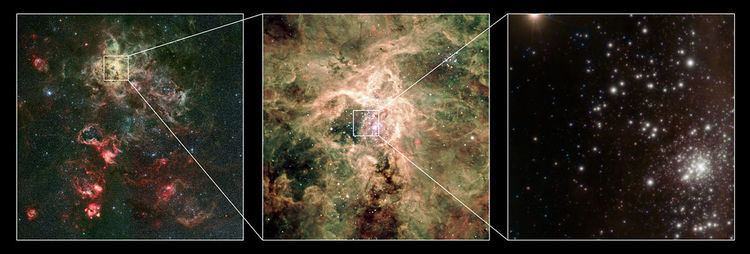Magnitude 12.86 Apparent magnitude (V) 12.86 | ||
 | ||
Similar R136a2, Melnick 34, VFTS 682, HD 37974 | ||
R136c is a star located in R136, an open cluster weighing 450,000 solar masses and containing 10,000 stars. It was first resolved and named by Feitzinger in 1980, along with R136a and R136b.
Contents
Description
R136c is a Wolf-Rayet star of the spectral type WN5h and with a temperature of 51,000 K. It is 230 times the mass of the sun and over five million times more luminous. The extreme luminosity is produced by the CNO fusion process in its highly compressed hot core. Typical of all Wolf-Rayet stars, R136c has been losing mass by means of a strong stellar wind with speeds over 2,000 km/s and mass loss rates in excess of 6995100000000000000♠10−5 solar masses per year. It is strongly suspected to be a binary, due to the detection of hard x-ray emission typical of colliding wind binaries, but the companion is thought to make only a small contribution to the total luminosity.
Death
R136c is so energetic that it has already lost a substantial fraction of its initial mass, even though it is only a few million years old. It is still effectively on the main sequence, fusing hydrogen at its core via the CNO cycle, but it has convected and mixed fusion products to the surface and these create a powerful stellar wind and emission spectrum normally only seen in highly evolved stars.
Its fate depends on the amount of mass it loses before its core collapses, but is likely to result in a supernova. The most recent models for single star evolution at near-solar metallicities suggest that the most massive stars explode as highly stripped type Ic supernovae, although different outcomes are possible for binaries. Some of these supernovae are expected to produce a type of gamma-ray burst and the expected remnant is a black hole.
